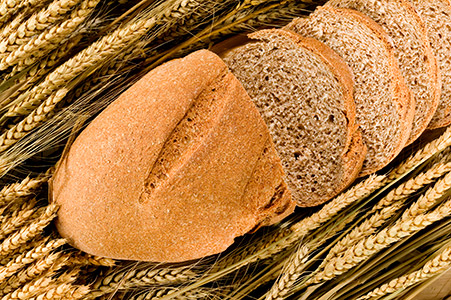Wheat allergy is most common in children, and is usually outgrown before reaching adulthood, often by age three. Symptoms of a wheat allergy reaction can range from mild, such as hives, to severe, such as anaphylaxis. Therefore it is advised that people with wheat allergy have quick access to an epinephrine auto-injector (such as an EpiPen®, Auvi-Q® or Twinject®) at all times. To prevent a reaction, strict avoidance of wheat and wheat products is essential. Always read ingredient labels to identify wheat ingredients.
A wheat allergy can present a challenge for the diet as well as for baking, because wheat is the nation’s predominant grain product. Someone on a wheat-restricted diet can eat a wide variety of foods, but the grain source must be something other than wheat. In planning a wheat-free diet, look for alternate grains such as amaranth, barley, corn, oat, quinoa, rice, rye, and tapioca. When baking with wheat-free flours, a combination of flours usually works best. Experiment with different blends to find one that will give you the texture you are trying to achieve.

Differences between Wheat Allergy and Celiac Disease or Gluten Intolerance
A wheat allergy should not be confused with “gluten intolerance” or celiac disease. A food allergy is an overreaction of the immune system to a specific food protein. When the food protein is ingested, in can trigger an allergic reaction that may include a range of symptoms from mild symptoms (rashes, hives, itching, swelling, etc.) to severe symptoms (trouble breathing, wheezing, loss of consciousness, etc.). A food allergy can be potentially fatal.
Celiac disease (also known as celiac sprue), which affects the small intestine, is caused by an abnormal immune reaction to gluten. Usually diagnosed by a gastroenterologist, it is a digestive disease that can cause serious complications, including malnutrition and intestinal damage, if left untreated. Individuals with celiac disease must avoid gluten, found in wheat, rye, barley and sometimes oats.
People who are allergic to wheat often may tolerate other grains. However, about 20 percent of children with wheat allergy also are allergic to other grains. Be sure to ask your doctor whether foods containing barley, rye, or oats are safe for you or your child to eat.
Avoiding Wheat The federal Food Allergen Labeling and Consumer Protection Act (FALCPA) requires that all packaged food products sold in the U.S. that contains wheat as an ingredient must list the word “Wheat” on the label.
Read all product labels carefully before purchasing and consuming any item. Ingredients in packaged food products may change without warning, so check ingredient statements carefully every time you shop. If you have questions, call the manufacturer.
As of this time, the use of advisory labels (such as “May Contain”) on packaged foods is voluntary, and there are no guidelines for their use. However, the FDA has begun to develop a long-term strategy to help manufacturers use these statements in a clear and consistent manner, so that consumers with food allergies and their caregivers can be informed as to the potential presence of the eight major allergens.
Avoid foods that contain wheat or any of these ingredients:
- Bread crumbs
- Bulgur
- Cereal extract
- Club wheat
- Couscous
- Cracker meal
- Durum
- Einkorn
- Emmer
- Farina
- Flour (all purpose, bread, cake, durum, enriched, graham, high gluten, high protein, instant, pastry, self-rising, soft wheat, steel ground, stone ground, whole wheat)
- Hydrolyzed wheat protein
- Kamut®
- Matzoh, matzoh meal (also spelled as matzo, matzah, or matza)
- Pasta
- Seitan
- Semolina
- Spelt
- Sprouted wheat
- Triticale
- Vital wheat gluten
- Wheat (bran, durum, germ, gluten, grass, malt, sprouts, starch)
- Wheat bran hydrolysate
- Wheat germ oil
- Wheat grass
- Wheat protein isolate
- Whole wheat berries
Wheat is sometimes found in the following:
- Glucose syrup
- Surimi
- Soy sauce
- Starch (gelatinized starch, modified starch, modified food starch, vegetable starch)
Some Unexpected Sources of Wheat*
- Read ingredient labels carefully, even if you would not expect the product to contain wheat. Wheat has been found in some brands of ice cream, marinara sauce, play dough, potato chips, rice cakes, turkey patties and hot dogs.
- Wheat also may be found in ale, baking mixes, baked products, batter-fried foods, beer, breaded foods, breakfast cereals, candy, crackers, processed meats, salad dressings, sauces, soups, soy sauce, and surimi.
- Some types of imitation crabmeat contain wheat.
*Note: This list highlights examples of where wheat has been unexpectedly found (e.g., on a food label for a specific product, in a restaurant meal, in creative cookery). This list does not imply that wheat is always present in these foods; it is intended to serve as a reminder to always read the label and ask questions about ingredients before eating a food that you have not prepared yourself.
Keep the following in mind:
- Many country-style wreaths are decorated with wheat products.
- Wheat flour is sometimes flavored and shaped to look like beef, pork, and shrimp, especially in Asian dishes.
